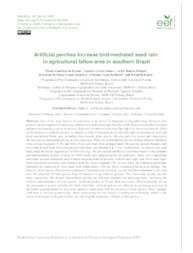Artificial perches increase bird-mediated seed rain in agricultural fallow area in southern Brazil.
Artificial perches increase bird-mediated seed rain in agricultural fallow area in southern Brazil.
Author(s): FREITAS, T. C. de; GOMES, G. C.; MOLINA, A. R.; GUARINO, E. de S. G.; ISERHARD, C. A.; BELTRAME, R.
Summary: One of the main barriers to restoration is the arrival of diaspores in degraded areas. However, this process can be hampered in open areas without trees in the landscape. For that, artificial perches are used to attract and provide a landing area for avian seed dispersers, to enhance seed rain. Our objective was to evaluate the effect of the distance of artificial perches in relation to a forest fragment on the diversity and composition of seed rain in an agricultural fallow area, including alien invasive plant species. We also aimed to record and characterize the bird species that potentially act as seed dispersers. Thus, we used artificial perches at three different distances from a forest fragment (5, 25, and 50 m). Four seed traps were arranged under the perches at each distance, and four control seed traps were interspersed with these and distanced at 7.5 m. Furthermore, we placed four seed traps inside the forest fragment at 5m from the edge.We also carried out 80 h of focal observation of the avifauna that used artificial perches. A total of 24 655 seeds were sampled across all treatments. There was a significant difference in seed abundance and richness between artificial perches, control seed traps, and forest seed traps. Seed deposition increased with distance from the forest fragment (50, 25, and 5 m). An ordination procedure indicated the formation of three plant seed communities, with the forest community being most distinct. The invasive exotic species Pittosporum undulatum (Australian cheesewood) was the third most abundant in the seed rain. We observed 24 bird species from 12 families using artificial perches. The Tyrannidae family was the most represented. We showed that artificial perches are efficient structures for attracting birds, increasing the richness and abundance of seed species. Artificial perches at 25 and 50m were more efficient possibly due to the provision of greater visibility for birds. Therefore, artificial perches are efficient in increasing seed rain in the fallow area but should be used with caution in landscapes with the presence of alien species. These findings contribute to increasing knowledge about overcoming the first barrier to ecological restoration, which is the arrival of diaspores in degraded areas, and showing the importance of birds in this process.
Publication year: 2022
Types of publication: Journal article
Observation
Some of Embrapa's publications are published as ePub files. To read them, use or download one of the following free software options to your computer or mobile device. Android: Google Play Books; IOS: iBooks; Windows and Linux: Calibre.
Access other publications
Access the Agricultural Research Database (BDPA) to consult Embrapa's full library collection and records.
Visit Embrapa Bookstore to purchase books and other publications sold by Embrapa.

